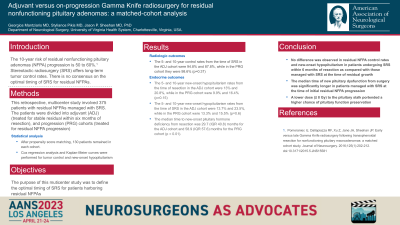Adjuvant versus on-progression Gamma Knife radiosurgery for residual non-functioning pituitary adenomas: a matched-cohort analysis
Adjuvant versus On-progression Gamma Knife Radiosurgery for Residual Non-functioning Pituitary Adenomas: A Matched-cohort Analysis
Friday, April 21, 2023


Georgios Mantziaris, MD
Research fellow
University of Virginia
Charlottesville, Virginia, United States
ePoster Presenter(s)
Introduction: Radiologic progression occurs in 50-60% of residual nonfunctioning pituitary adenomas (NFPAs). Stereotactic radiosurgery (SRS) is a safe and effective management option of residual NFPAs, but there is no consensus on the optimal timing. We hypothesized that the timing of radiosurgical management (adjuvant SRS versus on-progression) could affect patient outcomes. This study aims to define the optimal timing of SRS for NFPA residuals.
Methods: This retrospective, multicenter study involved 375 patients with residual NFPAs managed with SRS. The patients were divided into adjuvant (ADJ) (treated for stable residual within six months of resection), and progression (PRG) cohorts (treated for residual NFPA progression). Factors associated with tumor progression and clinical deterioration were analyzed.
Results: Following propensity score matching each cohort consisted of 130 patients. At last follow-up, tumor control was achieved in 93.1% patients in the ADJ and 96.2% patients in the PRG cohort [(Hazard ratio (HR)=1.6, 95% CI=0.55-4.9, p=0.370.51]). Hypopituitarism was associated with a maximum point dose of >8Gy to the pituitary stalk (HR=4.5, 95% CI=1.6-12.6, p=0.004). No statistically significant difference was noted in crude new-onset hypopituitarism rates [(15.4% and 16.2%Risk difference (RD) =-0.8%, p=1]) or visual deficits (1.5% and 3RD=-2.3.8%, p=0.21) between the two cohorts at last follow-up. The median time from resection to new hypopituitarism was longer in the PRG cohort (58.9 versus 29.7 months, p=0.01).
Conclusion : SRS at residual NFPA progression does not appear to alter the probability of tumor control or hormonal/visual deficits compared to adjuvant SRS. Deferral of radiosurgical management to the time of radiographic progression could significantly prolong the time to radiosurgical induced pituitary dysfunction. Lower maximum point dose dose ( < 8Gy) to the pituitary stalk portended a more favorable chance of preservation of pituitary function after SRS.
Methods: This retrospective, multicenter study involved 375 patients with residual NFPAs managed with SRS. The patients were divided into adjuvant (ADJ) (treated for stable residual within six months of resection), and progression (PRG) cohorts (treated for residual NFPA progression). Factors associated with tumor progression and clinical deterioration were analyzed.
Results: Following propensity score matching each cohort consisted of 130 patients. At last follow-up, tumor control was achieved in 93.1% patients in the ADJ and 96.2% patients in the PRG cohort [(Hazard ratio (HR)=1.6, 95% CI=0.55-4.9, p=0.370.51]). Hypopituitarism was associated with a maximum point dose of >8Gy to the pituitary stalk (HR=4.5, 95% CI=1.6-12.6, p=0.004). No statistically significant difference was noted in crude new-onset hypopituitarism rates [(15.4% and 16.2%Risk difference (RD) =-0.8%, p=1]) or visual deficits (1.5% and 3RD=-2.3.8%, p=0.21) between the two cohorts at last follow-up. The median time from resection to new hypopituitarism was longer in the PRG cohort (58.9 versus 29.7 months, p=0.01).
Conclusion : SRS at residual NFPA progression does not appear to alter the probability of tumor control or hormonal/visual deficits compared to adjuvant SRS. Deferral of radiosurgical management to the time of radiographic progression could significantly prolong the time to radiosurgical induced pituitary dysfunction. Lower maximum point dose dose ( < 8Gy) to the pituitary stalk portended a more favorable chance of preservation of pituitary function after SRS.
